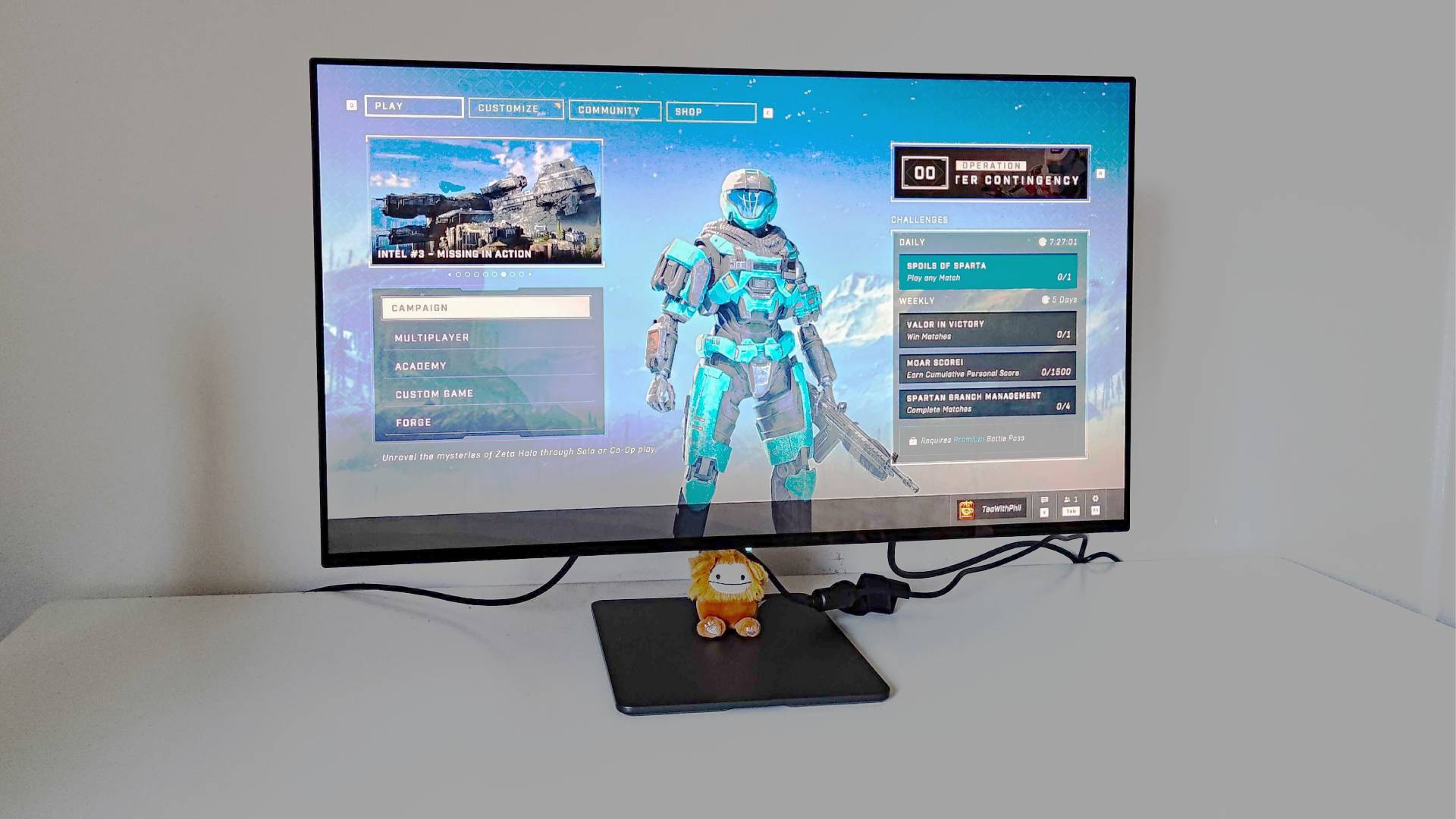GamesRadar+ Verdict
The latest Dough Spectrum One model pairs a glossy Gorilla Glass screen with an impressive 4K 144Hz panel to create a stand out gaming monitor experience. While the display’s reflective surface isn’t going to be to everyone’s tastes, it ultimately helps it deliver contrast and colors that truly hit differently, not to mention it really makes UHD gaming PC visuals pop.
Pros
- +
Great contrast and colors
- +
Speedy and responsive
- +
Built-in Steam Deck dock
Cons
- -
Pricey
- -
Doesn't come with a stand
- -
OSD controls fall short
Why you can trust GamesRadar+
Prior to taking the Dough Spectrum One for a test drive, I was convinced I’d hate using a glossy gaming monitor. The idea of using a screen that’s more reflective really just didn’t sit right with me, not to mention I was convinced it would end up looking grotty after two seconds of use. Yet, to my complete surprise, I think I’m now a bit of a glossy screen stan, as this is Gorilla Glass infused model the first LCD display I’ve used that feels like it can (sort of) compete with OLED.
Commanding a lofty $799 price tag , the Dough Spectrum One is certainly a premium best gaming monitor contender. That MSRP might sound affordable compared to some 4K 144Hz monitors that arrived when the standard debut, but Dough (formerly Eve) doesn’t include a stand by default. So, if you’re not planning on mounting this screen to an existing arm or bracket, you’ll have to fork out an additional $99.
For context, you can currently pick up a BenQ MOBIUZ EX3210U monitor with similar specs for $649.99, so the Dough Spectrum One had its work cut out for it. Thankfully, the 27-inch screen failed to disappoint during testing, and thanks to that Gorilla Glass display, it is now one of my favorite 4K gaming monitors of the year. There are a few minor gripes that keep this panel from achieving a perfect score, but nothing that’d prevent me from recommending it to anyone who’s big into screen clarity.
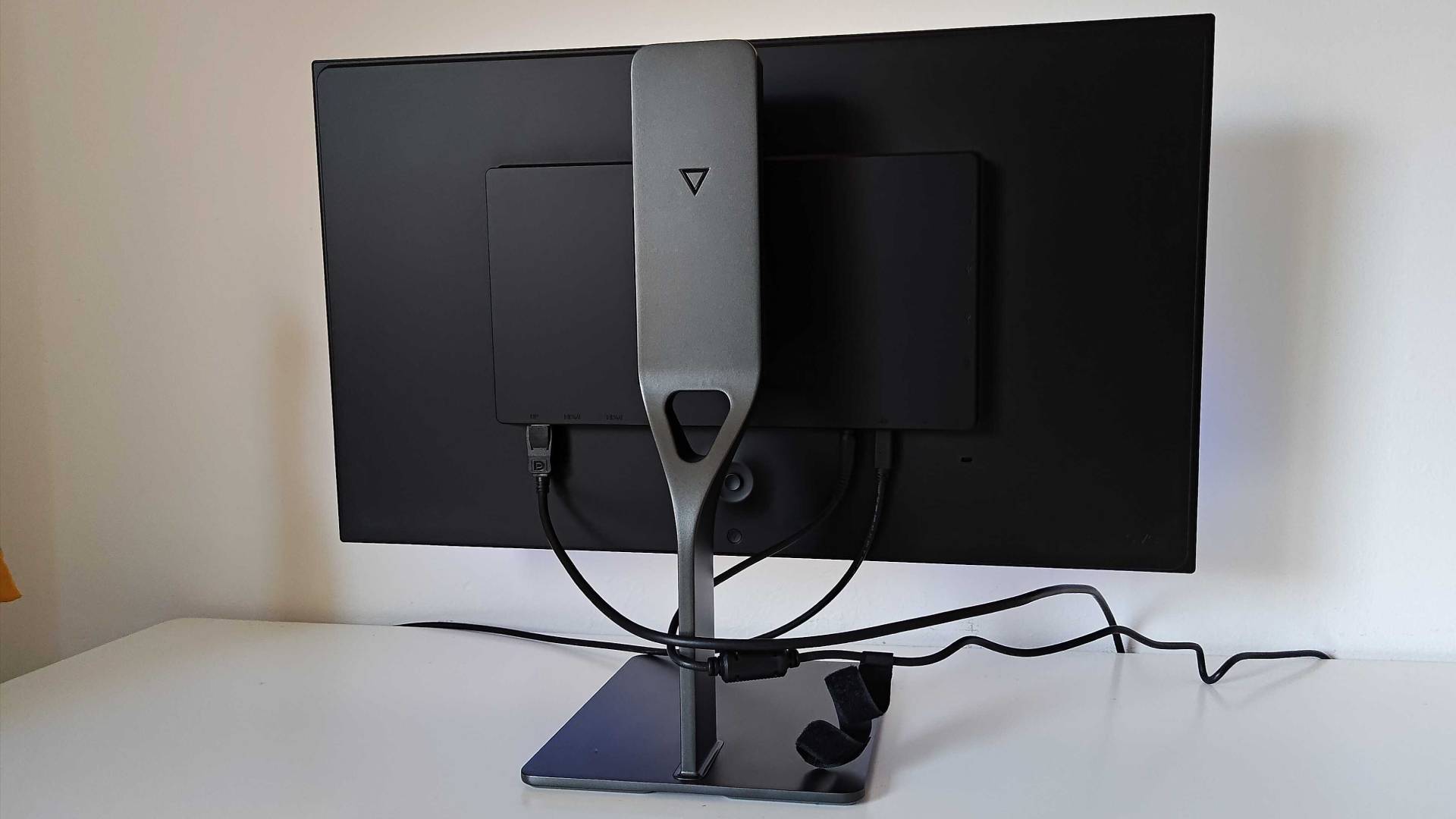
Specs
Before I dive into my wider Dough Spectrum One opinions and testing, let’s run through some specs. As touched on, this is a 27-inch 4K 144Hz gaming monitor with variable refresh rate, HDMI 2.1, and DisplayHDR 600. Other sort of expected perks include NVIDIA G-Sync and VESA Adaptive-Sync compatibility, but it’s also got a few tricks up its sleeve that you might not have been expecting.
For starters, the glossy screen on this specific model itself is made of Gorilla Glass – the same stuff as your smartphone. Just like with your pocket-sized supercomputer, this helps reduce some of the reflections normally associated with non-matt displays, but should also add to the general toughness of the panel.
| Price | $999 / £630 (est) |
| Screen size | 27-inches |
| Screen type | IPS |
| Resolution | 3840 x 2160 |
| Brightness | 450 nits / cd/m2 (Sustained) 750 nits / cd/m2 (Peak) |
| Response time | 1ms GtG |
| Viewing angle | 178° / 178° |
| Contrast ratio | 10,000,000:1 |
| Color support | 100% sRGB 98% DCI-P3 |
| Inputs | 2x HDMI 2.1, 1x Display Port 1.4, 4x USB-A, 2x USB-C, 3.5mm auxiliary audio output |
| Weight | 10.4 lb / 4.7 kg (without Stand) |
On that note it’s probably a good time to caveat that my test unit was actually damaged during its long shipping journey, with two visible dunts on the box translating to bruising on the LCD within. Thankfully, the light magenta marks are only visible when the screen goes completely black, so I was still able to conduct the review without major distractions. I’m not going to say the fact the screen didn’t completely smash is thanks to the Gorilla Glass used, but y’know, food for thought.
The other trick the Spectrum One wields is USB-C docking capabilities and 100W power delivery. As someone who routinely tests the best gaming handheld contenders, this is a huge boon, as it means I won’t have to reach for a Steam Deck dock and occupy one of the display’s ports.
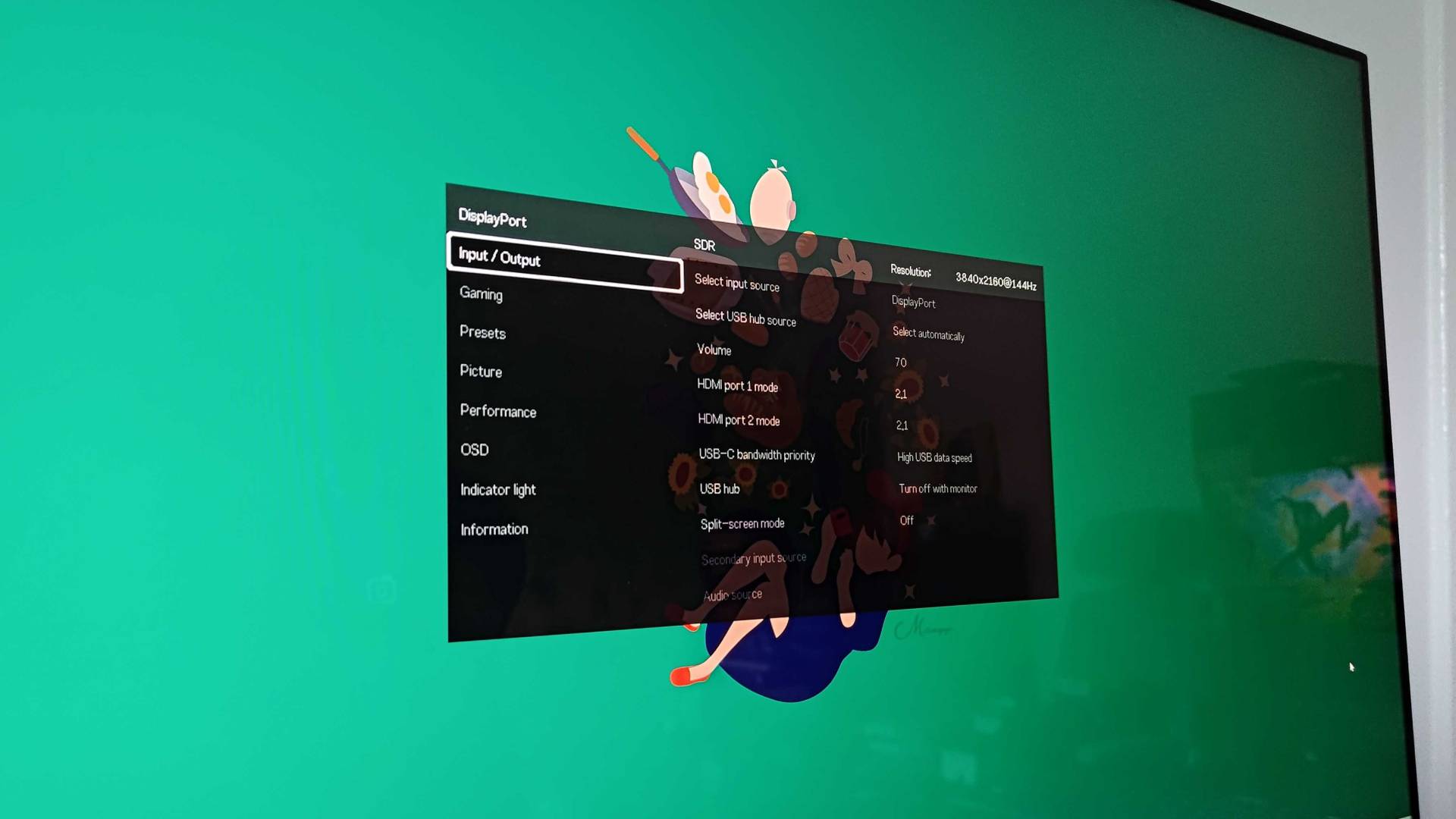
Design
Gaming monitors have a habit of all looking a bit samey, and I guess that’s deliberate. As much as I love cool looking tech, we don’t really need excessive designs distracting us from what’s on a display. With that in mind, I usually consider less to be more when it comes to screen aesthetics, and the Dough Spectrum One delivers on that front by keeping bezels to a minimum. I’d go as far to say that it wears one of the thinnest edges I’ve ever seen on a desktop monitor, with only black masking on the panel itself being visible at a glance.
Round the back reveals some of the Dough Spectrum’s chonk, which is to be expected since it’s not an OLED display. That said, it’s still a bit slimmer than other 4K monitors I've plonked on my desk, and its overall shape isn’t remotely intrusive. The screen’s IO all lives into the expected hump at the back, meaning it's easy to access on the fly by adjusting the optional stand’s height. You’ll also find the power button and joystick OSD controller under there too at the bottom.
If you’ve ever read any of my other monitor reviews, you’ll know I’m now going to rant about that aforementioned menu nub. It’s not the worst navigation nipple I’ve ever used, but the nature of it is susceptible to misclicks and settings shenanigans. Using the nob really falls flat when it comes to selecting inputs, as working out what direction to actually click in for shortcuts isn’t that intuitive. I’m also not sure why clicking to select something on the main menu typically kicks you back out rather than making the selection, and it’s small things like this that just make me crave either a remote control or simple individual buttons.
I wasn’t going to comment on the stand since it’s not included with the Dough Spectrum One itself, but I want to furnish it with some assembly praise. The process of whipping the monitor out of the box and clicking it onto the stand is as painless as screen setup gets, and I had everything set up within seconds. The pedestal itself is made of aluminium alloy, so you don’t have to worry about knocking it around while trying to get things mounted in place, and believe me, that is a thing that can happen.
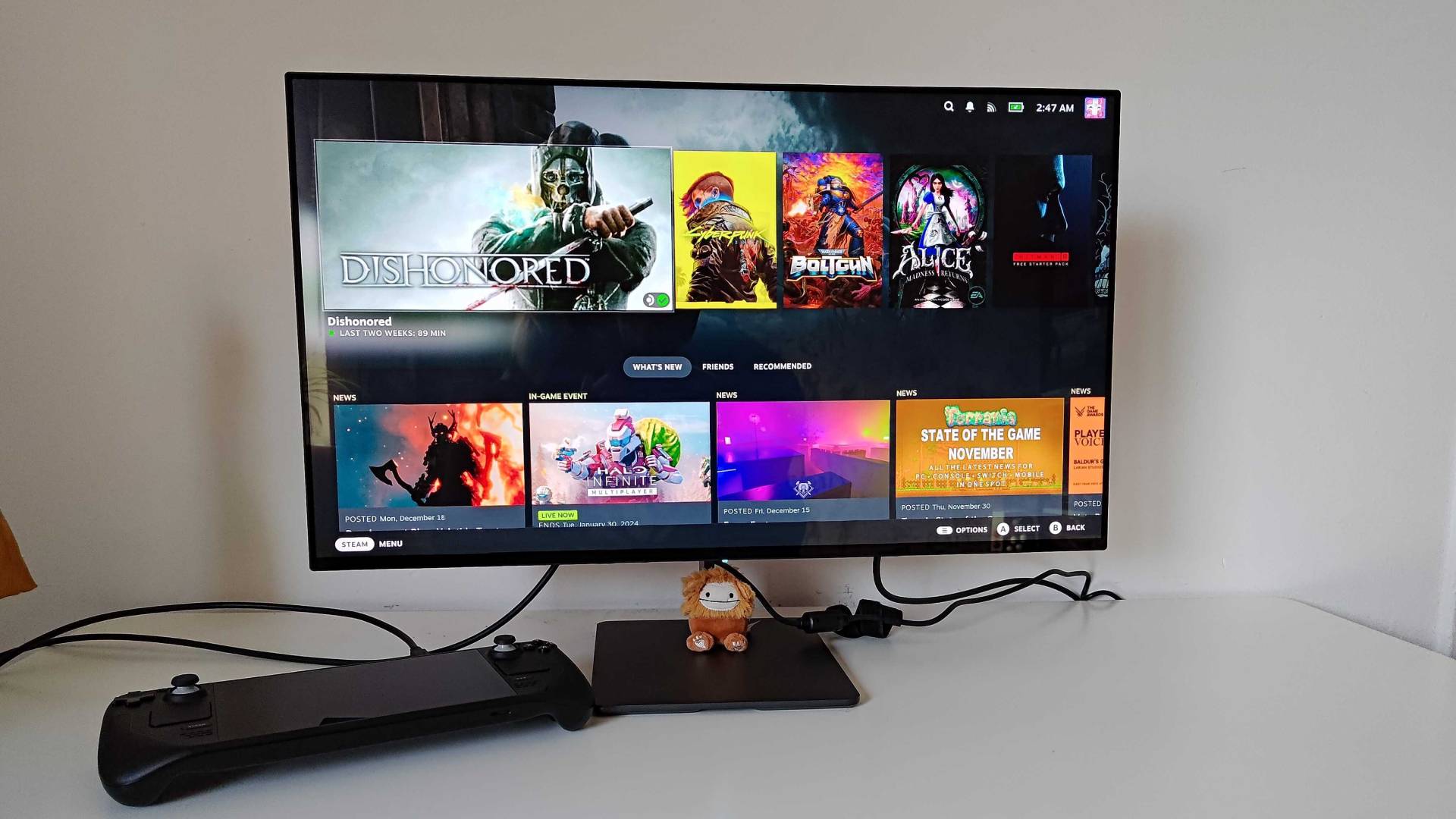
Features
I’m reserving any observations about the Dough Spectrum One’s glossy Gorilla Glass screen for the performance segment of this review, which provides me with a chance to delve deeper into subtle features. I say subtle, but the whole docking station thing is pretty rad, and I don’t come across many monitors that can fill the brief properly. Just keep in mind you’ll need a cable that’s actually capable of transmitting video over USB-C, otherwise you’ll get diddly squat on screen.
I actually got hold of the Dough Spectrum One at the perfect time, as I’m also currently wading through my Lenovo Legion Go review. Hooking up the handheld via USB-C effectively transforms it into a mini Windows 11 PC by providing it with all the connectivity you’ll need to play at your desk. Performance is still beholden to hardware, and the Legion GO specifically gave me a bunch of hassle when trying to use it on an external monitor. However, if you’ve got a Steam Deck or Asus ROG Ally to hand and fancy playing some indie games already installed on it, you’re pretty much good to go.
Better still, you’ll find a split-screen mode stowed away within this monitor’s settings, meaning you can use two devices at the same time. This is something I personally find incredibly handy, as I find myself using more than one PC at a time, but it also means you can do things like use Discord on a laptop while playing games on the Steam Deck. Hypothetical setups using split screen are pretty vast, and I’ll leave it to you to dream up weird combos
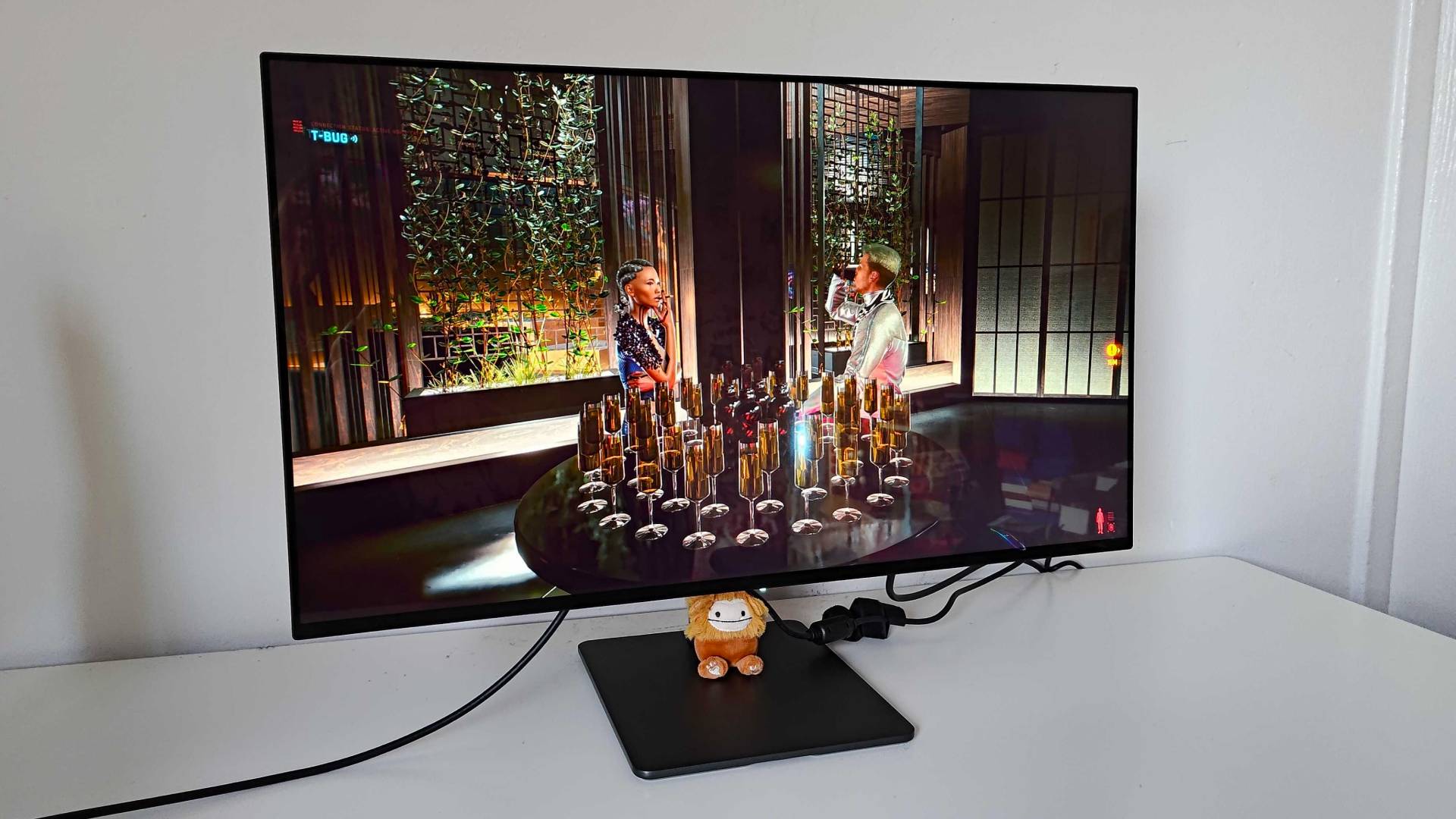
Performance
It’s about time we started chatting more about the Dough Spectrum One’s glossy Gorilla Glass screen, as it’s really the start of the show. I didn’t get a chance to try out the original Dough Spectrum to see how reflective it was, but going by this latest model alone, any fears of glare I previously had were completely unfounded.
From the minute I clapped eyes on the Dough Spectrum One in action, I knew that glossy display was going to be something special. Everything from vibrant icons to smaller pieces really pop on the 4K panel, and contrast is surprisingly on point considering we’re dealing with an ordinary IPS monitor. Don’t get me wrong, black levels aren't anywhere near the same as one of the best OLED monitors, and using HDR produces some weird lighting effects that remind you it’s an edge lit display. Still, the colors facilitated here are more than commendable, even when sticking with SDR in vibrant games.
As per usual, I took a trip to Night City using the Dough Spectrum One as my viewing portal, and I was more than pleased with the way Cyberpunk 2077 looked. Switching HDR didn’t quite produce the same results as something like the Corsair Xenon 27QHD240, as OLED monitors do something magical to the metropolis’ neon lights. Nevertheless, everything still looked pretty vivid, with the glossy screen highlighting the tremendous detail the RPG romp boasts in 4K.
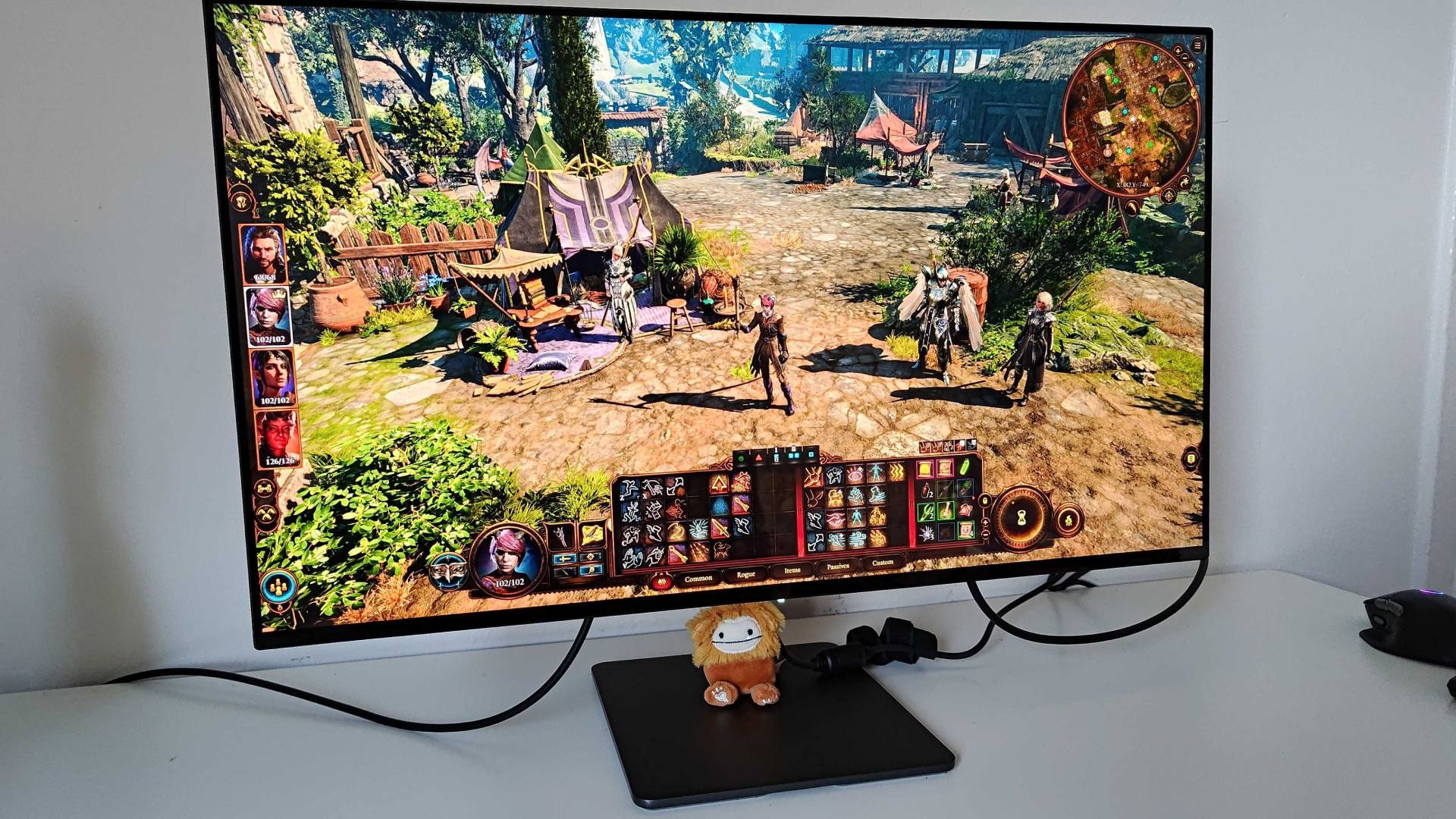
I’m holding out until the Christmas break to start a new Baldur’s Gate 3 campaign, but I couldn’t resist jumping into Faerun using the Spectrum One. I don’t want to sound too cheesy, but gazing upon the HUD and beautifully illustrated icons in the D&D game felt like reading a players handbook, and everything looked far richer on this monitor than it does on my daily driver.
Since this is a speedy 144Hz screen, I naturally felt inclined to jump into Halo Infinite to test responsiveness. My own lack of skill aside, everything felt as snappy as I was expecting, with that 1ms response time helping prevent me coming up with hardware excuses for my fails.
Rounding off visual tests, I also fished Hellboy: Web of Wyrd from my backlog, as I had a hunch that its comic book visuals would slap on this screen. And guess what? They absolutely do. Bold outlines and cell shading are beginning to strut their stuff on this screen, and even black elements of this game’s visuals look stellar on the Spectrum One. I haven’t got round to it yet, but I’m absolutely going to dig out my Wii U just to see what Wind Waker HD looks like when emanating from this glossy panel, as I’m willing to bet it looks incredible.
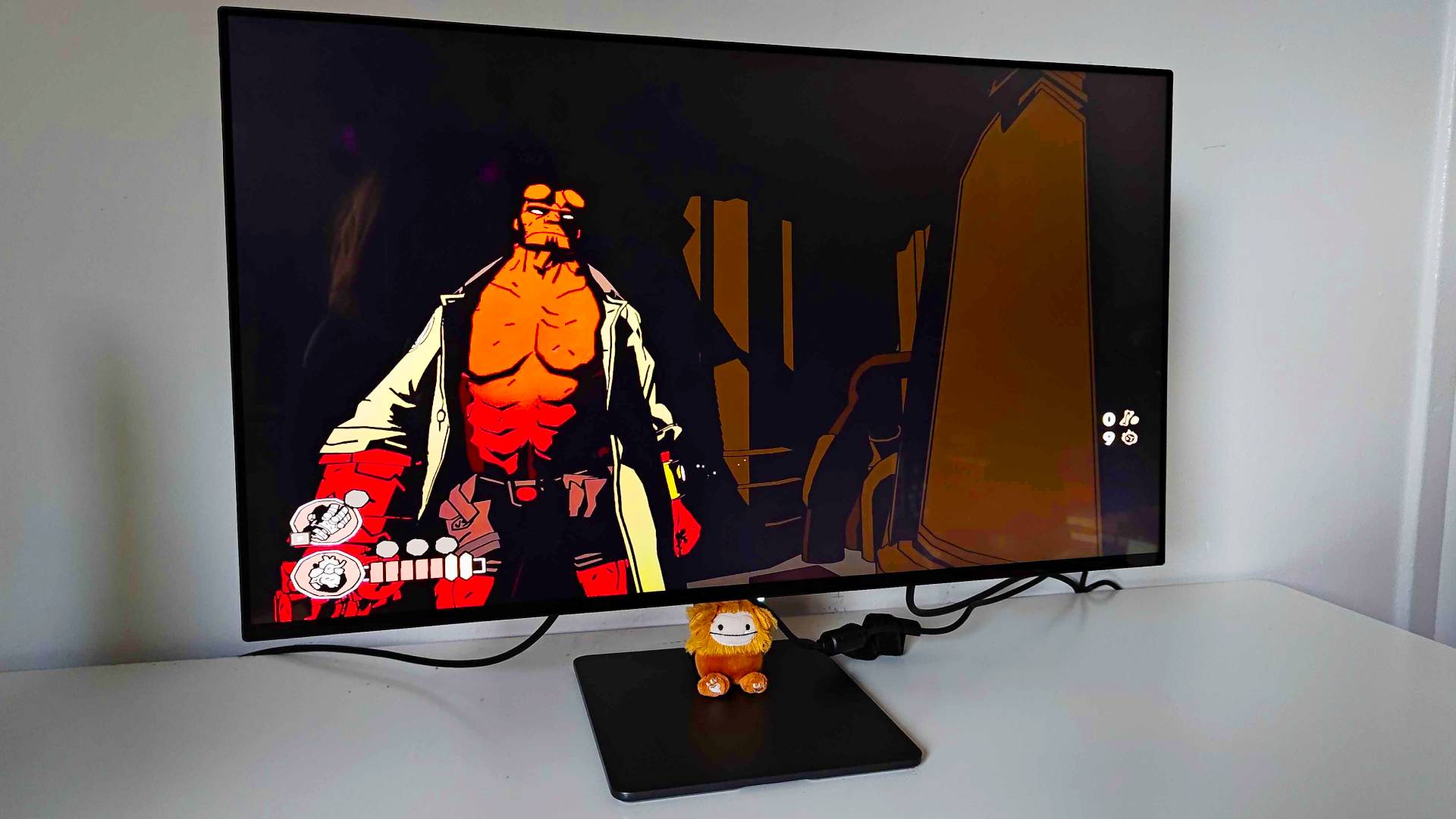
Should you buy the Dough Spectrum One?
If you’re in the market for a 4K 144Hz display and fancy giving something different a try, the glossy Dough Spectrum One is well worth considering. I do think it is a tad pricey considering premium monitors of this calibre are now dropping lower, and IPS tech can’t properly trump what OLED has to offer. Yet, the benefits of using a non-matte screen are abundantly clear, and I now consider it to be a huge selling point rather than an experimental quirk that I’d rather avoid.
I think if anything, it’s going to be the price that dissuades players from picking up the Dough Spectrum One. Sure, it’s got that built in 100W USB-C hub and a fancy new Gorilla Glass screen that proper kicks reflections to the curb. However, the whole not including a stand thing is going to matter when it comes to clicking buy, as it’s an extra expense that’s not going to be anticipated by many. Dough might frame it as providing versatility and letting customers pay for what they need, but I’m sure a majority of people are going to end up begrudgingly picking up the stand anyway.
How I tested the Dough Spectrum One
For around two weeks, I used the Dough Spectrum One as my main desktop display. For playing PC games, I hooked it up to my personal rig and ran the likes of Cyberpunk 2027, Halo Infinite, and Baldur’s Gate 3 at 4K 144Hz to assess image quality and responsiveness. I also connected the Steam Deck and Lenovo Legion Go to the screen using its 100W USB-C hub and ran lightweight indie games at 1080p.
For more information on how we carry out our reviews, swing by our GamesRadar+ Hardware policy for more details.
Looking for a bigger screen for your PC? Check out the best gaming TV options are supersize your setup. Alternatively, check out the best TV for PS5 and Xbox Series X if you're rocking a console.

I’ve been messing around with PCs, video game consoles, and tech since before I could speak. Don’t get me wrong, I kickstarted my relationship with technology by jamming a Hot Wheels double-decker bus into my parent’s VCR, but we all have to start somewhere. I even somehow managed to become a walking, talking buyer’s guide at my teenage supermarket job, which helped me accept my career fate. So, rather than try to realise my musician dreams, or see out my University degree, I started running my own retro pop culture site and writing about video games and tech for the likes of TechRadar, The Daily Star, and the BBC before eventually ending up with a job covering graphics card shenanigans at PCGamesN. Now, I’m your friendly neighbourhood Hardware Editor at GamesRadar, and it’s my job to make sure you can kick butt in all your favourite games using the best gaming hardware, whether you’re a sucker for handhelds like the Steam Deck and Nintendo Switch or a hardcore gaming PC enthusiast.
